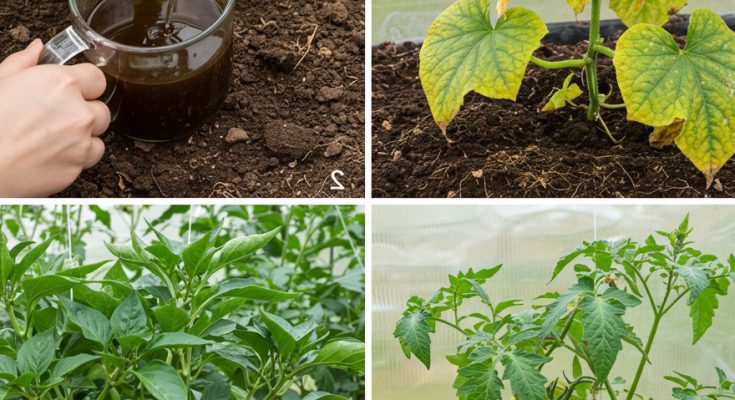This homemade, organic solution helps restore health, stimulate growth, and strengthen resistance to disease — all without synthetic fertilizers or harsh chemicals. Whether your plants are wilting, underperforming, or recovering from pests or heat stress, this method can breathe new life into your garden.
Why Plants Decline Mid-Season
Weak or “dying” plants often show signs of:
-
-
Yellowing or curling leaves
-
Slow or no growth
-
Weak stems and shallow roots
-
-
Lack of flowering or fruit set
-
Susceptibility to pests or fungal infections
Common causes include nutrient deficiencies, watering issues, poor soil quality, extreme weather, and damage from pests or diseases. Fortunately, most of these issues can be improved — or even reversed — by strengthening the plant’s natural resilience through feeding.
The Secret to Reviving Weak Plants: Nutrient-Dense Natural Feeding
Instead of reaching for chemical fertilizers that may shock already fragile plants, the best approach is to apply a gentle, well-balanced, natural feeding that promotes recovery and gradual strength.
This simple DIY recipe uses ingredients rich in vital minerals and natural growth stimulants that help:
-
-
Rebuild the root system
-
-
-
Encourage new leaf and stem development
-
Support flowering and fruiting
-
Improve disease resistance
-
Natural Revival Feeding Recipe
Ingredients:
-
-
1 liter of clean water (preferably rainwater or settled tap water)
-
1 tablespoon of wood ash or banana peel tea (rich in potassium and phosphorus)
-
1 teaspoon of liquid aloe vera or seaweed extract (natural growth hormone)
-
-
1 teaspoon of diluted honey or molasses (feeds beneficial microbes)
-
Optional: A small pinch of crushed eggshell or ground chalk (calcium source)
Preparation:
-
-
Mix all ingredients thoroughly in the water.
-
-
Allow the mixture to sit for 30 minutes to an hour to fully combine.
-
Stir well before use.
How to Apply the Feeding
-
-
Soil Drench: Slowly pour around the base of each plant (approximately 200–300 ml per plant).
-
-
Foliar Spray (optional): For very stressed plants, lightly mist the leaves in the early morning. Be sure to test a small patch first to avoid leaf burn.
Repeat the treatment every 5 to 7 days until plants show visible improvement.
Why This Works So Well
Each ingredient plays a key role in recovery:
-
-
Potassium and phosphorus (wood ash, banana peel tea): Stimulate root growth, flowering, and fruit development.
-
-
-
Aloe vera or seaweed extract: Contains plant hormones and micronutrients that promote cell regeneration and stress tolerance.
-
Honey or molasses: Acts as a natural microbial stimulant, improving soil health and nutrient absorption.
-
Calcium (eggshell): Helps prevent blossom-end rot and strengthens plant cell walls.
-
Together, these components provide a balanced “rescue formula” that nourishes the plant inside and out.
What to Expect After Application
Within a few days of the first feeding, many gardeners report:
-
-
Noticeably greener leaves
-
Sturdier stems and new shoot growth
-
-
-
Reduction in leaf yellowing or curling
-
Appearance of new flowers and fruit
-
Increased resistance to diseases and pests
-
While it may not bring back severely damaged plants, this natural feeding is incredibly effective at reviving those that are weak but still alive.
Tips to Support Recovery
In addition to this feeding, here are a few supportive practices:
-
-
Mulch around the base of plants to retain moisture and regulate temperature.
-
Remove dead or diseased leaves to reduce stress.
-
-
-
Water consistently but avoid overwatering, which can suffocate roots.
-
Provide light shade for heat-stressed plants during intense afternoon sun.
-
Stake or support drooping plants to prevent breakage while they regain strength.
-
Ideal Plants for This Feeding
This natural rescue feeding is ideal for:
-
-
Tomatoes that have stopped growing or dropped flowers
-
-
-
Cucumbers with yellowing leaves or limp vines
-
Peppers that look pale, aren’t flowering, or are stunted
-
Any other warm-season crop struggling during the peak of summer
-
It’s a safe, effective way to give your garden a second wind, even during the toughest part of the growing season.
Conclusion
No gardener wants to give up on their plants, and with this natural, nutrient-rich feeding, you won’t have to. Whether your cucumbers are drooping, your tomatoes aren’t setting fruit, or your peppers are slow to grow, this remedy offers a simple way to revive them using ingredients you likely already have at home.
Give this gentle, restorative feeding a try and watch your plants transform — stronger, greener, and more productive than before.
